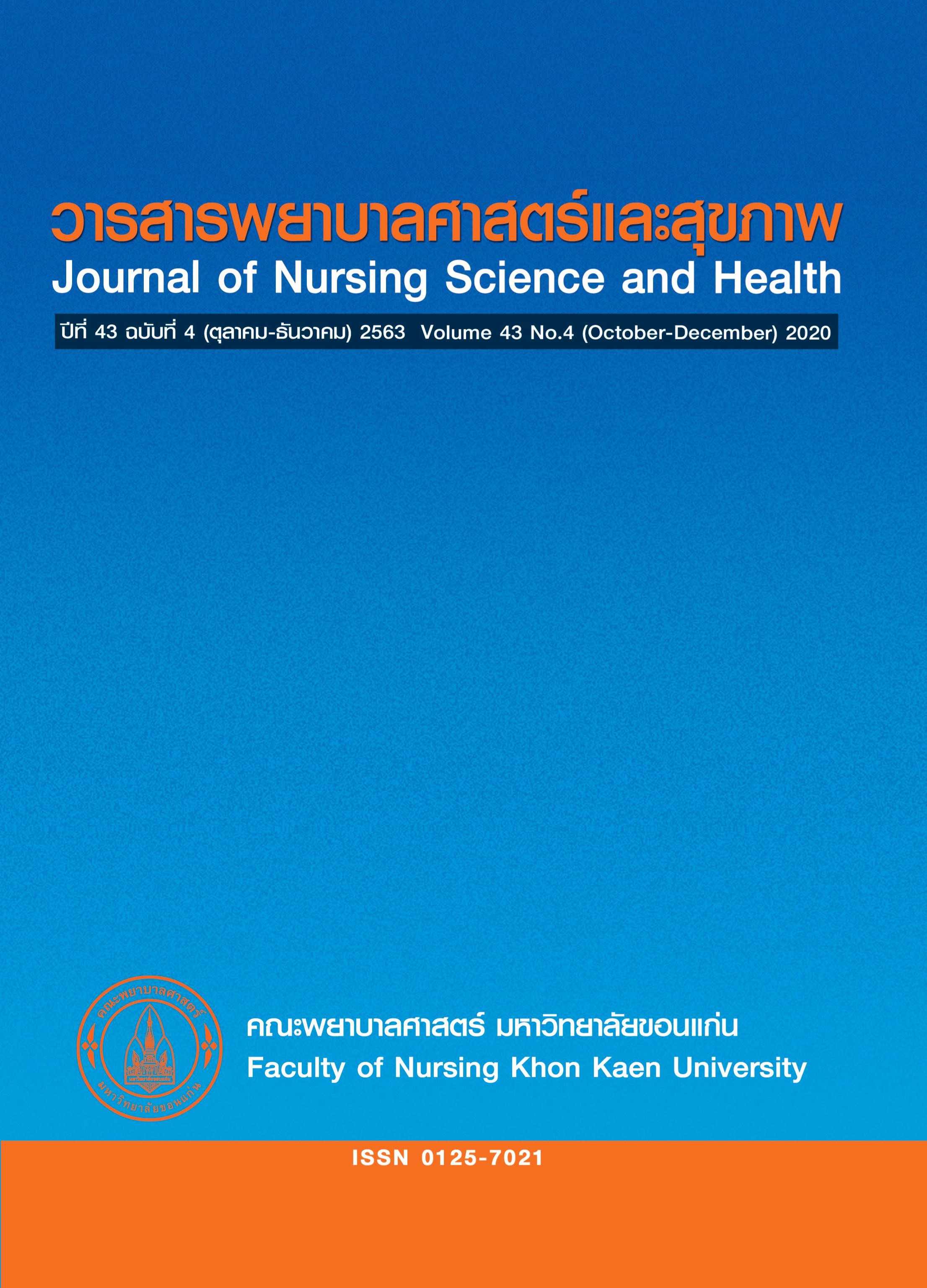ผลของการใช้รูปแบบการดูแลผู้ป่วยภาวะเลือดออกในทางเดินอาหารส่วนต้นต่อผลลัพธ์ที่คัดสรรในผู้ป่วยศัลยกรรม โรงพยาบาลตติยภูมิแห่งหนึ่ง
คำสำคัญ:
เลือดออกในทางเดินอาหารส่วนต้น, รูปแบบการดูแล, ผลลัพธ์ที่คัดสรรบทคัดย่อ
การวิจัยกึ่งทดลองนี้มีวัตถุประสงค์เพื่อศึกษาผลของการใช้รูปแบบการดูแลผู้ป่วยภาวะเลือดออกในทางเดินอาหารส่วนต้น (upper gastrointestinal bleeding care bundle; UGIB-CB) ต่อผลลัพธ์ที่คัดสรรในผู้ป่วยศัลยกรรม โรงพยาบาลตติยภูมิแห่งหนึ่ง กลุ่มตัวอย่างจำนวน 146 คน แบ่งเป็นกลุ่มทดลองและกลุ่มเปรียบเทียบกลุ่มละ 73 ราย กลุ่มทดลองได้รับการดูแลตาม UGIB-CB ส่วนกลุ่มเปรียบเทียบได้รับการดูแลตามปกติของโรงพยาบาล ผลลัพธ์ที่คัดสรรในการศึกษาประกอบด้วยผลลัพธ์ทางคลินิกและผลลัพธ์ด้านทรัพยากรมนุษย์ เครื่องมือที่ใช้ในการรวบรวมข้อมูล ได้แก่ แบบประเมิน UGIB-CB แบบประเมินความมีวินัยของพยาบาลวิชาชีพในการปฏิบัติตามกิจกรรมของ UGIB-CB และแบบประเมินความพึงพอใจของพยาบาลวิชาชีพต่อการใช้ UGIB-CB วิเคราะห์ข้อมูลโดยใช้สถิติพรรณนา หาค่าความถี่ ร้อยละ ค่าเฉลี่ย และส่วนเบี่ยงเบนมาตรฐาน และวิเคราะห์ผลของการใช้ UGIB-CB โดยใช้สถิติ independent t–test, chi-square และ relative risk
ผลการศึกษาพบว่า ผู้ป่วยกลุ่มทดลองได้รับการส่องกล้องตรวจระบบทางเดินอาหารส่วนบน (esophagogastroduodenoscopy; EGD) ตามระยะเวลาที่กำหนดมากกว่ากลุ่มเปรียบเทียบ 1.75 เท่า (RR = 1.75, 95% CI 1.26-2.44) และมีค่าเฉลี่ยปริมาณปัสสาวะภายใน 24 ชั่วโมงแรก มากกว่ากลุ่มเปรียบเทียบอย่างมีนัยสำคัญ (97.18 มิลลิลิตร และ 82.53 มิลลิลิตร ตามลำดับ, p = 0.03) พยาบาลสามารถปฏิบัติกิจกรรมตาม UGIB-CB ในระดับสูงมาก (ร้อยละ 95.89) และมีความพึงพอใจต่อการใช้ UGIB-CB โดยรวมในระดับมากที่สุด (ร้อยละ 82.93) ผลการศึกษาสะท้อนว่าการใช้ UGIB-CB ช่วยให้ผู้ป่วยมีความปลอดภัยและได้รับการทำ EGD ตามเวลาที่กำหนดและมีแนวโน้มที่ดีในการนำไปใช้
เอกสารอ้างอิง
Wongjitrat C, Wongchittarat N. Causes of upper gastrointestinal bleeding in hospitals, Her RoyalHighnessPrincessMahaChakriSirindhorn Medical center. Department of Internal Medicine Faculty of Medicine, Srinakharinwirot University 2013; 20: 46-52. (in Thai)
Iamcharoen T. Postpartum hemorrhage: The important role of nurses in prevention of postpartum hemorrhage: Significance of nurse’s roles in prevention. Private Higher Education Institute of Thailand under the Patronage of Her Royal Highest Princess Maha Chakri Sirindhorn Siam Borom Rajakarn 2017; 6: 146-57. (in Thai)
Viprakasit V. Approach to childhood anemia. J Hematol Transfus Med 2014; 24: 395-405.
Basile DP, Anderson MD, Sutton TA. Pathophysiology of acute kidney injury. Compr Physiol 2014; 2: 1303–53. doi:10.1002/cphy.c110041.
Medical Statistics, Khon Kaen ospital. Surgical patient statistics 2015-2017. Khon Kaen: Medical Record and Statistics Section, Khon Kaen hospital; 2017. (in Thai)
MRCP FFICM IASE, FRCA PKB, MRCP FRCA FFICM SI. Management of acute upper GI bleeding. BJA Education 2017;17(4):117-23. doi: 10.1093/bjaed/mkw054
Tang Y, Shen J, Zhang F, Zhou X, Tang Z, You T, et al. Scoring systems used to predict mortality in patients with acute upper gastrointestinal bleeding in ED. AM J EMERG MED 2018;36:27-32.
Abdelrahman M, Hornby S. Upper gastrointestinal haemorrhage. DOCME 2017;35:649-57.
Siau K, Chapman W, Sharma N, Tripathi D, Iqbal T, Bhala N. Management of acute upper gastrointestinal bleeding: An update for the general physician. J R Coll Physicians 2017; 47:218-30.
Chaikitchokamnuay R, Pathumannon C. The score for predicting the severity of gastrointestinal bleeding in 2014. J Public Health 2016;25:421-35.
Leone M, Asfar P, Radermacher P, Vincent J, Martin C. Optimizing mean arterial pressure in septic shock: A critical reappraisal of the literature. Crit Care 2015;19(101):1-7. doi:10.1186/s13054-015-0794-z.
Jetsrisuphap A. Basic laboratory tests in hematology and factors that cause the results to be inaccurate. J Hematol Transfus Med 2016;26(2):91-5. (in Thai)
Ngamjarus C, Chongsuvivatwong V. N4 Studies: Sample size and power calculations for android. [dissertation]. The Royal Golden Jubilee: The Thailand Research Fund & Prince of Songkla University;2014. (in Thai)
The Joanna Briggs Institute. School of translational health scienceand. The joanna briggs institute 2014 annual report; 2014. Available from: https://onesearch.library.uwa. edu.au/discovery/fulldisplay?docid=alma 9931464502101&context=L&vid=61UWA_ INST:UWA&search_scope=MyInst_and_CI&tab=Everything&lang=en by linking through and searching for JBI20468
Srisamrit A, Panprasert S, Panmethit I. Development of Caring System for Patients with Upper Gastrointestinal Hemorrhage. JND 2014; 41(1): 36-55. (in Thai)
Li C, Yun D. Improvement effect of early goal-directed therapy on the prognosis in patients with septic shock. Chin Crit Care Med 2015;27(11):899-905.
Semler MW, Rice TW. Sepsis resuscitation: Fluid choice and dose. Clin Chest Med 2016; 37(2): 241-50. doi:10.1016/j.ccm.2016.01.007.
Suksathien S. Causes and factors predicting the occurrence of early gastrointestinal bleeding. MNRH 2019; 41:21-8.
Nuengnasuwan W, Nomkusol J, Thongjam R, Panaput T. Development of the nursing service system for patients with severe sepsis. J NAT-MED 2014; 32(2): 25-36. (in Thai)
ดาวน์โหลด
เผยแพร่แล้ว
รูปแบบการอ้างอิง
ฉบับ
ประเภทบทความ
สัญญาอนุญาต
วารสารพยาบาลศาสตร์และสุขภาพเป็นเจ้าของลิขสิทธิ์ในการเผยแพร่ผลงานที่ตีพิมพ์ห้ามผู้ใดนำบทความที่ได้รับการตีพิมพ์ในวารสารพยาบาลศาสตร์และสุขภาพไปเผยแพร่ในลักษณะต่าง ๆ ดังนี้ การนำบทความไปเผยแพร่ออนไลน์ การถ่ายเอกสารบทความเพื่อกิจกรรมที่ไม่ใช่การเรียนการสอน การส่งบทความไปตีพิมพ์เผยแพร่ที่อื่น ยกเว้นเสียแต่ได้รับอนุญาตจากวารสารพยาบาลศาสตร์และสุขภาพ



